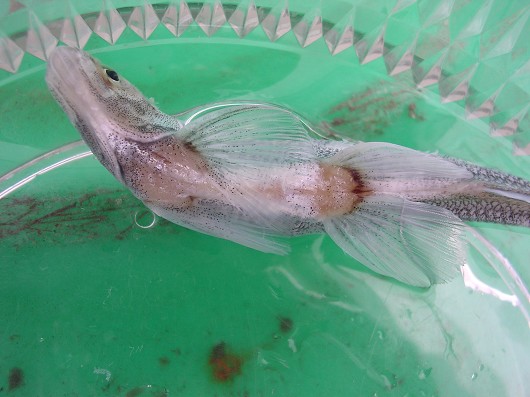Longfin Smelt
-
Scientific NameSpirinchus thaleichthys
-
NativeYes
-
Identification
 Longfin smelt, male, 141 mm FL. Photographed on March 7, 2008 at the Tracy Fish Collection Facility, Tracy, CA. Photo by René Reyes, US Bureau of Reclamation.
Longfin smelt, male, 141 mm FL. Photographed on March 7, 2008 at the Tracy Fish Collection Facility, Tracy, CA. Photo by René Reyes, US Bureau of Reclamation. Longfin smelt, 110 mm FL. Photographed on February 14, 2008 at the Tracy Fish Collection Facility, Tracy, CA. Photo by René Reyes, US Bureau of Reclamation.
Longfin smelt, 110 mm FL. Photographed on February 14, 2008 at the Tracy Fish Collection Facility, Tracy, CA. Photo by René Reyes, US Bureau of Reclamation. Longfin smelt, ventral view, 150 mm FL. Photographed on February 22, 2008 at the Tracy Fish Collection Facility, Tracy, CA. Photo by René Reyes, US Bureau of Reclamation.
Longfin smelt, ventral view, 150 mm FL. Photographed on February 22, 2008 at the Tracy Fish Collection Facility, Tracy, CA. Photo by René Reyes, US Bureau of Reclamation.- Small silvery fish, adipose fin present, adults reach 12-15 cm SL
- Long pectoral fin may reach pelvic fin origin, long maxillary bone may reach past eye
- Striations on operculum weak or absent, lower jaw protrudes
- Teeth present on tongue, vomer, palatines, and both jaws
- Olive to pink iridescent backs, silvery sides
- Mature males: usually darker than mature females, dilated lateral line, large stiff dorsal and anal fins, breeding tubercles on scales and paired fins
- Fin rays: dorsal 8-10, anal 15-22, pectoral 10-12
- Lateral line scales: (incomplete) 54-65
-
Life History
Longfin Smelt in California are primarily an anadromous estuarine species that can tolerate salinities ranging from freshwater to nearly pure seawater. Most Longfin Smelt occupy the middle or bottom of a water column and tend to favor temperatures in the range of 16-18°C and salinities ranging from 15-30 ppt. Their spatial distribution within a bay or estuary is seasonally variable. Generally speaking Longfin Smelt are found closer to the ocean during summer whereas they move upstream in cool seasons. They can survive summer temperatures up to 20°C. Longfin Smelt may also make daily migrations; remaining deep during the day and rising to the surface at night. Avoiding surface waters during the day helps these fish avoid predation from birds, marine mammals, and other fish. In addition Longfin Smelt may follow food sources which include opossum shrimp, copepods, and crustaceans. Longfin Smelt reach 6-7 cm SL in the first 9-10 months of life. Growth is minimal during their first winter, but the growth rate increases again in their second summer and fall when they may reach 9-11 cm SL. The largest Longfin Smelt are female fish that reach standard lengths up to 15 cm in their third year. Longfin Smelt move into freshwater to spawn, with the peak breeding season occurring between February and April. Older and larger fish tend to spawn in the later stages of the spawning season. Males are first to move into areas with gravel or sandy substrate where rocks and aquatic plants are present. Spawning occurs at night, when female Smelt release an average of 5,000-24,000 adhesive eggs. Smelt typically die after spawning though a few females may survive another year. The eggs hatch in around 40 days and the larvae are washed downstream into the estuary. In the San Francisco estuary high stream flows seem to lead to higher resulting populations of Smelt. Larvae are mobile and move according to salinity preferences. In 30-60 days the larvae morph into juvenile fish.
-
Links to Other ResearchN / A


